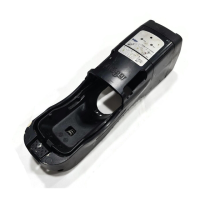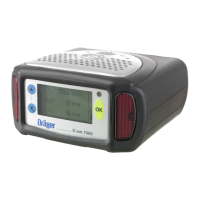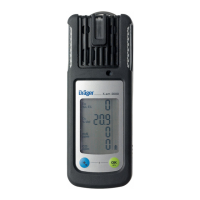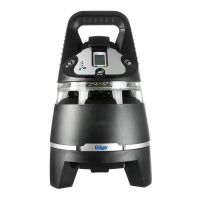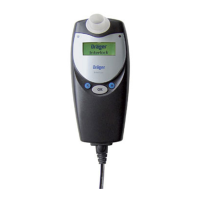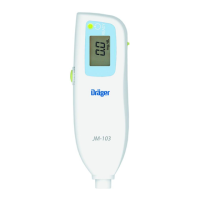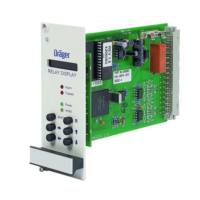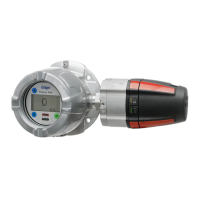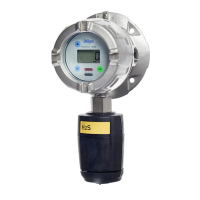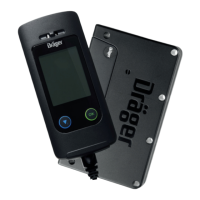Use
Dräger X-am 2500 13
3.4 Running the bump test
3.4.1 Manual implementation without documentation of
the results in the instrument memory
1. Prepare a test gas cylinder,
the volume flow must be
0.5 l/min and the gas
concentration must be
higher than the alarm
threshold concentration
that is to be tested.
Example test gas cylinder
68 11 130 = mixed gas with
50 ppm CO, 15 ppm H
2
S,
2.5 vol. % CH
4
, 18 vol. % O
2
2. Connect the test gas
cylinder with the calibration
cradle (order no. 83 18 752).
3. Vent the test gas into
a fume cupboard or into the
open air (with a hose connected to the second connector of
the calibration cradle).
4. Switch on the instrument and insert it into the calibration
cradle – press downwards until it engages.
5. Open the test gas cylinder valve to let test gas flow over
the sensors.
Recommendation: Wait until the instrument displays the
test gas concentration with sufficient tolerance –
Ex: ±20 % of the test gas concentration
1
O
2
: ±0.6 vol. %
1
TOX: ±20 % of the test gas concentration
1
Wait until at least alarm threshold A1 or A2 has been
exceeded, however.
If the alarm thresholds are exceeded, the instrument
displays the gas concentration in alternation with »A1« or
»A2« depending on the test gas concentration.
6. Close the test gas cylinder valve and remove the
instrument from the calibration cradle.
If the concentration has now fallen under the A1 alarm threshold:
z Acknowledge the alarm.
If the displays are outside of the above-mentioned ranges:
z Calibrating/adjusting the instrument, see section 5 on
page 17.
3.4.2 Menu implementation with the documentation of
results in the instrument memory
The setting to "Quick bump test" or "Accelerated bump test" is
made using the PC software Dräger CC Vision.
In the "Quick bump test" a check is carried out as to whether
or not the gas concentration has exceeded alarm threshold 1
(with oxygen, the test checks that alarm threshold 1 has not
been reached).
In the "Accelerated bump test" a check is carried out as to
whether or not the gas concentration has exceeded alarm
threshold 1 (with oxygen, the test checks that the alarm
threshold has not been reached) and whether or not the gas
concentration has reached the set bump test concentration.
Setting on delivery: Quick bump test.
1. Prepare a test gas cylinder, the volume flow must be 0.5 l/min
and the gas concentration must be higher than the alarm
threshold concentration that is to be tested.
Example test gas cylinder 68 11 130 = mixed gas with
50 ppm CO, 15 ppm H
2
S, 2.5 vol. % CH
4
, 18 vol. % O
2
2. Connect the test gas cylinder
with the calibration cradle
(order no. 83 18 752)).
3. Vent the test gas into a fume
cupboard or into the open
air (with a hose connected
to the second connector of
the calibration cradle).
4. Switch on the instrument and insert it into the calibration
cradle – press downwards until it engages.
5. Open the Quick menu and
select the bump test,
page 16.
The current gas
concentration values and
the special symbol » «
(for bump test) flash.
6. Press the key to start
the bump test.
7. Open the test gas cylinder
valve to let test gas flow
over the sensor.
If gas concentration exceeds
the alarm thresholds A 1 or
A 2 the corresponding alarm
will occur.
CAUTION
Never inhale the test gas. Health hazard! Observe the
hazard warnings of the relevant Safety Data Sheets.
1 Upon application of the Dräger mixed gas (order no. 68 11 130) the displays
should be within this range.
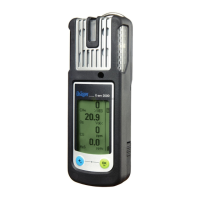
